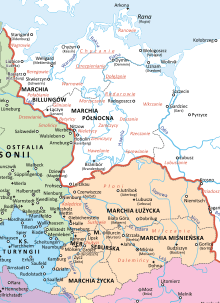German–Polish War (1002–18)
The German–Polish War which took place from 1002 to 1018 consisted of a series of struggles between the Ottonian king Henry II of Germany (Holy Roman Emperor from 1014) and the Polish Piast ruler Bolesław I the Brave. The locus of conflict was the control of Lusatia, Upper Lusatia, as well as Bohemia, Moravia and Slovakia.[1] The fighting ended with the Peace of Bautzen in 1018, which left Lusatia and Upper Lusatia as a fief to Poland, and Bohemia became a duchy in the Holy Roman Empire.
| German–Polish War | |||||||||
|---|---|---|---|---|---|---|---|---|---|
| |||||||||
| Belligerents | |||||||||
|
|
| ||||||||
| Commanders and leaders | |||||||||
| Henry II | Bolesław I the Brave | ||||||||
Background

Bolesław maintained good relations with Emperor Otto III, together they fought against the West Slavic Lutici tribes and the Polabian Slavs. The Polish ruler also allied with Margrave Eckard of Meissen to contain the influence of the Přemyslid dukes of Bohemia. In 1000 Bolesław and Otto met at the Congress of Gniezno and solemnly celebrated their mutual recognition and friendship.
The circumstances changed significantly, when in January 1002 Emperor Otto III suddenly died at the age of 21, leaving no heirs nor any succession arrangements. The Bavarian duke Henry IV, member of a cadet branch of the Ottonian dynasty, raised claims to become King of the Romans–against rivalling Margrave Eckard of Meissen, who within a few weeks was attacked and killed by Saxon nobles. Henry was elected king in Mainz on June 7.
The followers of late Margrave Eckard and his sons Herman and Eckard II sought support from Bolesław. The Piast ruler himself referred to both his former marriage with a daughter of the earlier deceased margrave Rikdag and his present marriage with Emnilda, daughter of a Lutici prince, in order to expand his influence to the Lusatian and Meissen marches beyond the Polish border. King Henry in turn renewed his Bavarian fellowship with the Přemyslid rulers of Bohemia, old-time enemies of the Polish Piast dynasty.
Conflict
The armed conflict can be divided into three phases.
1002–1005
In July 1002, Bolesław proceeded to a council with King Henry at the Kaiserpfalz of Merseburg in Saxony to deliberate on the enfeoffment of Meissen. As his claims were rejected, he left the royal court with disappointment. Moreover, an attempt was made on Boleslaw's life, which he escaped only with the help of Duke Bernard of Saxony, the Nordgau margrave Henry of Schweinfurt and several friendly German nobles. While it is not known for sure if the attack had been ordered by Henry and the contemporary chronicler Thietmar of Merseburg denied any complicity, Bolesław believed this was the case. In any case Henry did neither protect him, nor did he punish the assailants.
Bolesław started the feud when he had Strehla Castle in the Margraviate of Meissen set ablaze on his way back to Poland. The fighting began in late 1002, whereby the Polish ruler could rely on the support by Margrave Henry of Schweinfurt, whose expectations to become Bavarian duke had been disappointed by Henry. The German king further antagonised the Saxon nobility, when he forged an alliance with the pagan Luitici tribes against the Christian Polish realm on Easter 1003 in Quedlinburg. In turn, Henry had Margrave Gunzelin of Meissen, Eckard's brother, arrested and reached the commitment of several Saxon bishops.
After Bolesław had invaded Bohemia to depose Duke Boleslaus III, he was combated both by the Bohemian nobility and Boleslaus' brother Jaromír on the side of the German king. The fighting did not stop until Henry with Bohemian and Lutici support launched a campaign to Poznań, where a peace was concluded. As a result, Bolesław unlike his ally Henry of Schweinfurt refused to submit to King Henry, but had to give up his earlier conquests in Lusatia and Meissen.
1007–1013
In 1007, Bolesław, possibly preempting an attack by Henry, once again marched against the Luitici tribes. His campaign took him up to the gates of Magdeburg and he regained control of eastern Lusatia and Meissen. After several unsuccessful campaigns by the German king from 1010 onwards, another peace was agreed to in Merseburg in 1013. This time Bolesław kept eastern Lusatia and the Milceni lands around Bautzen as Imperial fiefs. He also received military aid from Henry for his intervention in the Kievan succession crisis. In return, Bolesław swore an oath of allegiance, promised to support Henry's bid for the crown of Holy Roman Emperor and aid him in his Italian campaigns. To confirm the alliance, Bolesław's son Mieszko II Lambert married the German noblewoman Richeza of Lotharingia, a distant relative of King Henry.
1015–1018
After Merseburg, Bolesław got entangled in the Kievan succession crisis backing his son-in-law Sviatopolk I against Henry's candidate Yaroslav the Wise. He thereby failed to support Henry in Italy and also refused to acknowledge Meissen and Lusatia as fiefs; he believed he held them independently of the Empire. To enforce Bolesław's submission, Henry had his son Mieszko II taken hostage and did not release him until 1014 following pressure from Saxon nobles.
Bolesław consistently refused to come before the German king. As a result, in 1015 Henry, supported by his pagan Liutician allies, launched another armed expedition against him. He attempted to cross into Greater Poland but was stopped by Bolesław's troops at Krosno on the Oder River. In 1017 Henry renewed his campaign, while Yaroslav attacked Poland from the eastern side. The emperor's troops besieged Niemcza in Silesia, however, with the help of outside reinforcements the city held out and Henry was eventually forced to retreat. The war spread over to Bohemia, where Mieszko's forces ravaged the lands and, while Bolesław again lost control over Kiev, peace efforts were resumed by the Saxon nobility.
Peace of Bautzen
In January 1018 Archbishop Gero of Magdeburg, Bishop Arnulf of Halberstadt, Margrave Herman of Meissen, the Wettin margrave Theodoric II of Lusatia, and Henry's ministeriales declared the Peace of Bautzen, which left eastern Lusatia and the Milceni lands (later Upper Lusatia) with Bolesław. The contemporary chronicle by Thietmar of Merseburg does not give details of the treaty. Historians have differed in their interpretation whether these were granted to Boleslaw as imperial fiefs, or if he held them with full sovereignty. Emperor Henry II did not renew the campaigns against Bolesław thereafter and the peace was confirmed by Bolesław's marriage with Oda of Meissen, daughter of Margrave Eckard I.
Footnotes
- McKitterick, R.; Reuter, T. (1995). The New Cambridge Medieval History: Volume 3, C.900-c.1024. Cambridge University Press. p. 523. ISBN 9780521364478. Retrieved 2015-04-05.
References
- Jasienica, Pawel (2007). Polska Piastów (in Polish). Proszynski Media. ISBN 978-83-7648-284-2.
- Rosik, Stanisław; Przemysław, Wiszewski (2006). Księga królów i książat polskich (in Polish). Wydawnictwo Dolnośląskie. ISBN 978-83-7384-604-3.
- Jan, Lerski; Wrobel, Piotr; Kozicki, Richard (1996). Historical Dictionary of Poland. Greenwood Publishing Group. ISBN 978-0-313-26007-0.


